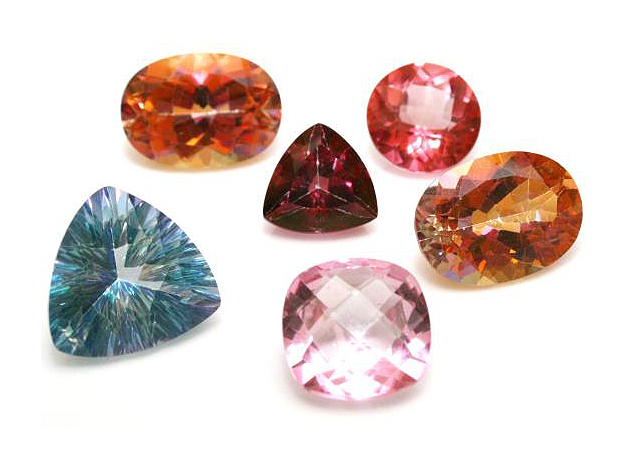The ancient Greeks believed topaz gave the wearer great strength and could also make them invisible. Some other attributes and uses through the ages for the stone include increasing the appetite, treating hemorrhages, protecting eyesight and combating blood disorders. The ancient Egyptians wore yellow topaz and thought that it represented their sun god Ra.
Along with citrine, yellow topaz is a birthstones for November, while blue is the birthstone for December. But the stone occurs in more than these two colors. It also occurs in red, peach, orange, gold, pink, yellow, clear (the color of pure topaz) and brown. Some pink is obtained by heat-treating brownish yellow stones from Brazil. Certain shades of blue are also made by irradiating. It is a very hard stone, and jewelry made from it is very durable and should be stored separately from other jewelry to avoid scratches. Topaz is found in many parts of the world, including Siberia, Russia, Sri Lanka, China, Africa, Pakistan, Mexico, South America and areas of The United States.
The jewelry for the Russian Czarinas in the 18th and 19th centuries continued red and pink. That is why the gem is sometimes called Imperial Topaz. The most famous stone is a colorless one that was originally thought to be a diamond. It is a stone set in the crown jewels of Portugal, and weighs 1680 carats.
There are two theories as to how it got its name. One theory says that the name came from the island of Topazos which is in the Red Sea. The Romans got a stone from this island that was not really topaz, but peridot or chrysolite. The other theory says that the stone got its name from the Sanskrit word tapas, which means fire.
Topaz is a readily attainable and affordable gemstone used in jewelry, with the price depending on the quality of the stone. The most popular color today is any shade of blue, with some of the other colors of the stone being very expensive. Topaz, the stone of strength is also one of great beauty.
Along with citrine, yellow topaz is a birthstones for November, while blue is the birthstone for December. But the stone occurs in more than these two colors. It also occurs in red, peach, orange, gold, pink, yellow, clear (the color of pure topaz) and brown. Some pink is obtained by heat-treating brownish yellow stones from Brazil. Certain shades of blue are also made by irradiating. It is a very hard stone, and jewelry made from it is very durable and should be stored separately from other jewelry to avoid scratches. Topaz is found in many parts of the world, including Siberia, Russia, Sri Lanka, China, Africa, Pakistan, Mexico, South America and areas of The United States.
The jewelry for the Russian Czarinas in the 18th and 19th centuries continued red and pink. That is why the gem is sometimes called Imperial Topaz. The most famous stone is a colorless one that was originally thought to be a diamond. It is a stone set in the crown jewels of Portugal, and weighs 1680 carats.
There are two theories as to how it got its name. One theory says that the name came from the island of Topazos which is in the Red Sea. The Romans got a stone from this island that was not really topaz, but peridot or chrysolite. The other theory says that the stone got its name from the Sanskrit word tapas, which means fire.
Topaz is a readily attainable and affordable gemstone used in jewelry, with the price depending on the quality of the stone. The most popular color today is any shade of blue, with some of the other colors of the stone being very expensive. Topaz, the stone of strength is also one of great beauty.



Good blog, thanks for sharing this useful information, we provide the best astrology for your date of birth, click the links to see your horoscope based on your date of birth.
ReplyDeleteMarriage Horoscope by Date of Birth
Marriage Astrology Based on Date of Birth
Marriage Prediction by Date of Birth Free
Free Marriage Prediction by Date of Birth
Marriage Astrology by Date of Birth
Astrology by Date of Birth for Marriage
wonderful Post!! Thanks To Shared With Your Post!!Indian Astrologer in Toronto | Geniue Astrologer in Toronto
ReplyDelete